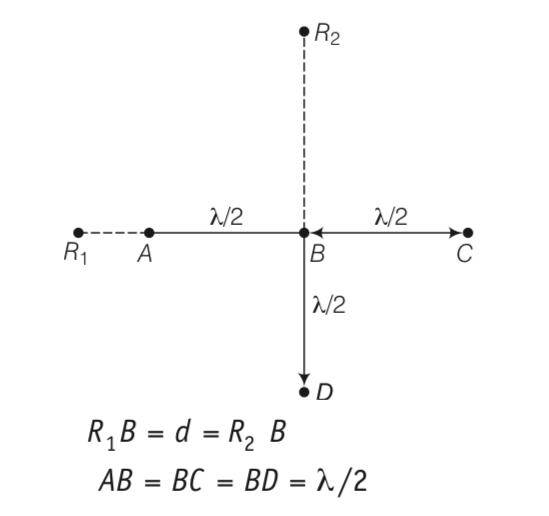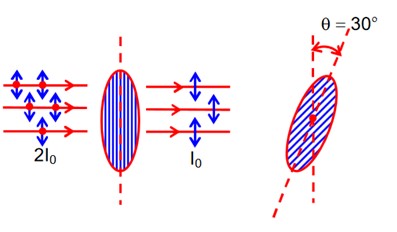Four identical monochromatic sources A, B, C, D as shown in the (figure)
produce waves of the same wavelength λ and are coherent. Two receiver
R1 and R2 are at great but equal distances from B.
(i) Which of the two receivers picks up the larger signal?
(ii) Which of the two receivers picks up the larger signal when B is turned off?
(iii) Which of the two receivers picks up the larger signal when D is turned off?
(iv) Which of the two receivers can distinguish which of the sources B or D has been turned off?

Four identical monochromatic sources A, B, C, D as shown in the (figure)
produce waves of the same wavelength λ and are coherent. Two receiver
R1 and R2 are at great but equal distances from B.
(i) Which of the two receivers picks up the larger signal?
(ii) Which of the two receivers picks up the larger signal when B is turned off?
(iii) Which of the two receivers picks up the larger signal when D is turned off?
(iv) Which of the two receivers can distinguish which of the sources B or D has been turned off?

-
1 Answer
-
This is a Long Answer Type Questions as classified in NCERT Exemplar
Explanation-consider the disturbance at the receiver R1 which is at a distance d from B
YA= acos(wt) and path difference is hence phase difference is .
Thus the wave R1 because of B
YB= acos(wt- )= - acoswt here path difference is and hence phase difference is
Thus R1 because of C
Yc= acos(wt-2 )= acoswt
(i)let the signal picked up at R2 from B be YB= a1cos(wt)
The path difference between signal at D and that B is
YD= -a1cos(wt)
The path difference between signal at A and that atB is
-d = d( -d =
therefore path difference os 0
A=a1co
...more
Similar Questions for you
The angle between the plane of vibration and plane of polarization is 90°.
At lower end
Tension, T? = 2g = 20 N (due to the 2 kg block)
Velocity, v? = √ (T? /μ) = √ (20/μ)
Wavelength, λ? = 6 cm
At upper end
Tension, T? = (2 kg + 6 kg)g = 8g = 80 N (due to the block and the rope)
Velocity, v? = √ (T? /μ) = √ (80/μ) = √4 * √ (20/μ) = 2v?
Since frequency (f) remains the same:
f = v? /λ? = v? /λ?
⇒ λ? = λ? * (v? /v? )
⇒ λ? = λ? * (2v? /v? ) = 2λ?
⇒ λ? = 2 * 6 cm = 12 cm
β = λD / (d? + a? sinωt)
β? - β? = λD/ (d? - a? ) - λD/ (d? + a? )
= λD [ (d? + a? ) - (d? - a? ) / (d? ² - a? ²) ]
= 2λDa? / (d? ² - a? ²)
3d = 0.6mm
D = 80cm
= 800mm
Path difference is given by
BP – Andhra Pradesh = Dx
[for Dark fringe at P]
n = 0, for first dark fringe
first dark fringe is observed on the screen directly opposite to one of the slits]
Taking an Exam? Selecting a College?
Get authentic answers from experts, students and alumni that you won't find anywhere else
Sign Up on ShikshaOn Shiksha, get access to
- 65k Colleges
- 1.2k Exams
- 678k Reviews
- 1800k Answers

